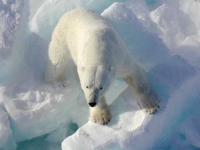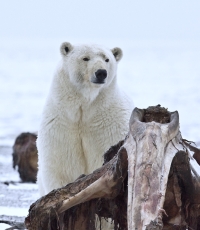There are many myths about what a Polar Bear will or will not eat in order to survive. It’s been said that they will devour fish, penguins, seals, and even whales. While it is known that a polar bear will eat just about anything if it’s hungry enough, some animals just aren’t that easy for a polar bear to catch. Known as the Great White Hunter, polar bears have the reputation of being able to eat nearly 100 pounds of blubber in a single sitting.

They have large appetites and are classified as the largest meat eater in the world. These bears need a lot of food in order to survive in the harsh climate. Male Polar Bears can weigh anywhere from 775 to 1,200 pounds, and females normally around 330 to 650 pounds. The females reach their top weight in the fall when they are ready to enter their maternity dens.
Do polar bears eat penguins?
Table of Contents
There is no doubt that a polar bear would love to eat a penguin if it could get its paws on it. The problem with catching penguins is that there are none in the artic to eat. Polar bears only live in the arctic circle, which includes countries like the United States, Canada, Russia, Greenland, and Norway. Penguins live much further south, about 7,458 miles further south. You will find a penguin either in the Antarctic, surrounding southern points of South America, Africa, and Australia, or on the scattered islands in between. So polar bears have no chance of even seeing a penguin unless, of course, it’s in a zoo.
Do polar bears eat fish?
Unlike its cousin to the south, the Grizzly Bear, who feasts on the salmon and trout runs every year; Polar Bears do not eat fish. They would if they could, but most Arctic fish are very deep in the water, and Polar Bears do not dive that far down. In the summer, they may catch a salmon or a cod, but fish is not a main staple of the Polar Bears diet.
What else do polar bears eat?
The favorite meal for the Polar Bear is the Bearded or Ringed Seal. The Ringed Seal has an average weight of 150 pounds. Polar Bears love to eat the skin and blubber of the seal and leave the remains for scavengers like the Arctic fox. They catch the seals by waiting at the mouth of an aglu, which is a breathing hole the seals use every five to fifteen minutes or so.

Sometimes the seals may be at another opening, and the polar bear will have to wait hours, sometimes even days, before they appear again. When the seals actually come up onto the ice to bask, the bear will stalk in and take advantage of the time they spend sleeping in the sunshine. Crawling forward slowly and stopping whenever the seals raise their heads, the bear will get within 20 feet of the seal then pounce it before it has a chance to escape into the sea.
Polar Bears are very opportunistic creatures; during the winter, when a Beluga Whale or a Narwhal finds itself trapped in the pack ice, the bear will seize the opportunity and eat the much larger blubber rich mammals. They don’t limit themselves to just marine animals; they will also eat reindeer, eggs, birds, and Arctic foxes. During the summer months, when their favorite food becomes harder to find, they will turn to eat anything that is available, including grass, berries, and mosses. And in times of desperation, they have been known to eat the garbage that humans leave behind as well.
